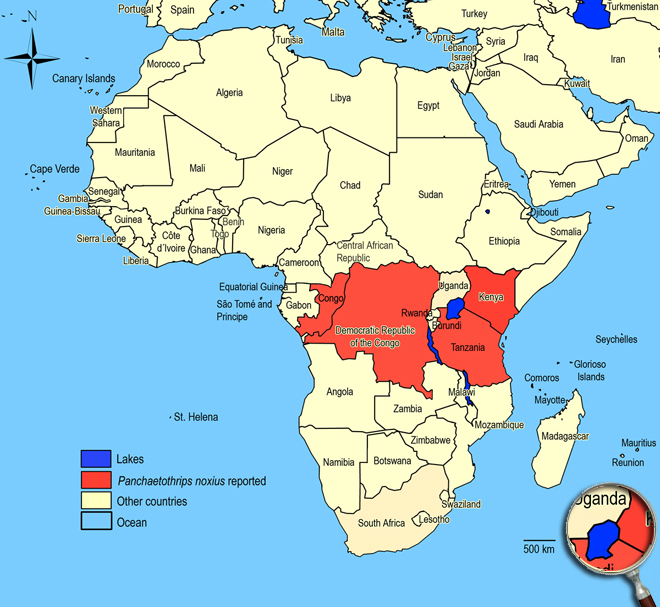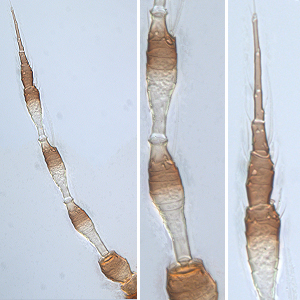Panchaetothrips noxius Priesner, 1937
Panchaetothripinae, Thripidae, Terebrantia, Thysanoptera
Figures
Fig. 1: 8-segmented antenna, segments III and IV with forked sense cone, terminal segments V-VIII
Fig. 2: Head with 8-segmented antenna
Fig. 3: Head with ocellar triangle
Fig. 4: Pronotum
Fig. 5: Meso- and metanotum
Fig. 6: Fore wing and fore wing basal region
Fig. 7: Tergites IV-VII
Fig. 8: Tergites VI-IX
Fig. 9: Tergites IX-XI
Fig. 10: Tergites X and XI
Fig. 11: Adult female
Introduction and recognition
Panchaetothrips noxius causes damage especially on coffee leaves. Both sexes fully winged. Body brown; tarsi and apices of tibiae yellow; antennal segments III-V yellow in basal half; fore wings light brown with white spot sub-basally; setae on fore wings dark brown, setae at apex of abdomen yellow (Fig. 11). Antennae 8-segmented; segments III & IV slender with sense cone long and forked; VIII more than 3 times as long as VII (Fig. 1 and 2). Head with cheeks S-shaped, but constricted to basal neck posterior to strong occipital ridge (Fig. 3). Pronotum with weak transverse lines of sculpture (Fig. 4). Mesonotum not divided medially. Metanotum with weakly defined reticulate triangular area medially and 2 pairs of setae (Fig. 5); metafurca elongate and Y-shaped. Mid and hind tarsi 2-segmented. Fore wing first vein close or fused to costal vein, fore wing costal setae dark and up to twice as long as wing width; first vein with row of about 7 setae not closely and uniformly spaced; second vein without setae (Fig. 6). Tergite II with group of closely spaced striae anterolaterally; tergites with conspicuously dark, stout and long setae (Fig. 7 and 8), tergite X long and cylindrical with complete longitudinal division dorsally (Fig. 10).
Male similar to female; without thorn-like setae on tergite IX; with slender, transverse, linear glandular area on each of sternites III-VII.
Taxonomic identity
Species
Panchaetothrips noxius Priesner, 1937
Taxonomic history
-
Common name
-
Present taxonomic position
Family: Thripidae Stephens, 1829
Subfamily: Panchaetothripinae Bagnall, 1912
Genus: Panchaetothrips Bagnall, 1912
Genus description
The genus Panchaetothrips Bagnall, 1912
Although 6 species are listed in this genus, they cannot all be distinguished satisfactorily (Mound & Postle 2004). One species is widespread in tropical Africa, the other five have been described from the Oriental region, between India, Japan, Philippines and northern Australia. All of them have the head with a strong transverse occipital ridge, the fore wing costal vein and tergites VIII-X bear unusually long and stout setae, the abdominal segment 10 is elongate and unusual tubular with stout setae (Mound & Kibby 1998), unlike any other member of the Panchaetothripinae.
Species description
Typical key character states of Panchaetothrips noxius
Coloration and body sculpture
Body color: mainly brown to dark brown or distinctively bicolored
Surface of head, pronotum and fore legs: with heavy, often polygonally reticulate sculpture
Sculptured reticles on head and pronotum: with no internal markings
Antennae
Form of sense cones on antennal segments III and IV: emergent and forked on segments III and IV
Number of antennal segments: 8
Terminal antennal segments: VI-VIII forming a single unit
Head
Cheeks shape: constricted to basal neck
Head - occipital ridge dorsally: present
Head: not prolonged in front of compound eyes
Ocelli: present
Head occipital collar: in contrast to rest of head weakly sculptured
Prothorax
Pronotal blotch or internal apodeme: absent
Pronotum shape: broadly rectangular
Mesothorax
Mesonotum: with an incomplete median division
Metathorax
Metanotum with dominant sculptured triangle medially: absent
Shape of metathoracic furca: elongate and Y-shaped
Wings
Fore and hind wings: present, more than half as long as abdomen (macropterous)
Fringe cilia arising: from sockets
Fore wing veins: present
Fore- and hind wing surface: covered with microtrichia
Apex of fore wing: with prominent terminal setae
Fore wing anterior margin (costal vein): with setae and cilia but cilia longer than setae
Fore wing costal fringe cilia: arising at anterior margin of wing
Fore wing first vein: close to or fused to costal vein
Fore wing first vein setal row: incomplete, with setae not closely and uniformly spaced
Fore wing second vein setal row: with no setae
Fore wing shape: mainly parallel sided or margins run continuously towards each other
Fore wing surface: not reticulate
Fore wing costal setae: long and dark, lower setal row missing
Fringe cilia on posterior margin near apex: distinctly wavy (undulated)
Shape of fore wing apex: with mainly posterior margin curved to join anterior margin
Length of fore wing costal setae at middle of wing: longer than half or about twice or more as long
of median wing width
Fore wing extreme apex color: dark
Fore wings: entirely brown, sometimes with slightly pale areas subapically, medially and subbasally or uniformly dark or shaded, but with base or sub-base pale
Legs
Mid and hind tarsi: with two segments
Color of fore tarsi: pale or yellow, sometimes apical shaded or brown
Abdomen
Tergite II: without specialised cuticles laterally
Tergites IV and V median setal pair: shorter than distance between their bases
Tergite VIII to X: with unusually long and stout setae
Tergites: without distinctive tergal sculpture forming a series of arches on the antecostal ridges
Tergites: with conspicuously dark, stout and long setae
Tergite X: tubular, longitudinally incomplete
Setae on abdominal tergite X: all setae slender

Similar or related species
Compared to other members of Panchaetothripinae, Panchaetothrips noxius has the tergite X long and unusually tubular, the fore wing costal vein and tergites IV-X bear dark, particularly long and stout setae, and the second vein of fore wings bears no setae. It is similar to species of Hercinothrips and Monilothrips kempi in having 2-segmented tarsi. But compared to Panchaetothrips noxius, species of Hercinothrips have a finely reticulated pronotum, usually banded fore wings, complete rows of long setae on both veins of the fore wings, and costal setae of fore wings longer than half of median wing width. Panchaetothrips noxius as well as Monilothrips kempi have a distinct occipital ridge on head, a pronotum without strong sculpture, and no posteromarginal comb of microtrichia on tergite VIII. Unlike Panchaetothrips noxius, in Monilothrips kempi the surface of the head is not strongly reticulated except for the occiptal collar, the head has no constriction posteriorly, the pronotum with 2 pairs of elongated setae, and both veins of fore wings have a complete row of long setae. Compared to other Panchaetothripinae with a distinct occipital ridge, in Panchaetothrips noxius and Helionothrips errans the occipital collar is weakly sculptured in contrast to the rest of the head. In Xestothrips glabratus is no difference between sculpture of occipital collar and rest of head and in Monilothrips kempi the occipital collar is in contrast to the rest of the head with heavy reticulate sculptured. Panchaetothrips noxius, Monilothrips kempi and Selenothrips rubrocinctus have fore wing costal setae up to twice as long as wing width medially. Selenothrips rubrocinctus has uniformly dark brown fore wings, 1-segmented tarsi, a complete posteromarginal comb of microtrichia on tergite VIII, and a pronotum with transverse striate sculpture.
Biology
Life history
As with other thrips species the life cycle from egg to adult is dependent on temperature. The full cycle can take about 15 days (Lewis 1973) to over a month and adults may live for more than one month producing several generations in one year depending on seasonal weather.
Host plants
Breeding on, and damaging, the leaves of coffee (Coffea arabica, Coffea robusta).
Vector capacity
None identified, but possible mechanical distribution of phytopathogenic fungi and bacteria.
Damage and symptoms
-
Detection and control strategies
-
Additional notes
-
Biogeography
Africa. Congo (Nioka, Kivu, Loashi), Tanzania, Uganda (Kisoro, Butenga).
African countries where Panchaetothrips noxius has been reported

The species Panchaetothrips noxius was not observed in surveys undertaken in East Africa on vegetables and associated weeds and crops.
Please click here for survey sites of all observed thrips species of Kenya, Tanzania and Uganda.

Bibliography
Faure JC (1962). Thysanoptera of Africa - 8. Revue de Zoologie et de Botanique Africaines. 66 (1-2): 165-183
Hood JD (1954). Angolan Thysanoptera I. A new genus and species of Heliothripinae. Publicacóes Culturais da Companhia de Diamantes de Angola. 24: 23-31
Lewis T (1973). Thrips: their biology, ecology and economic importance. Academic Press Inc., London Ltd., 349 pp
Lewis T (1997). Thrips as crop pests. CAB International, Wallingford, 740 pp
Moritz G (2006). Thripse. Pflanzensaftsaugende Insekten, Bd. 1, (1. Auflage). Westarp, Hohenwarsleben, 384 pp. ISBN-13: 978 3 89432 891 7
Moritz G, Morris DC & Mound LA (2001). ThripsID - Pest thrips of the world. ACIAR and CSIRO Publishing Collingwood, Victoria, Australia, CDROM ISBN 1 86320 296 X
Moritz G, Mound LA, Morris DC & Goldarazena A (2004). Pest thrips of the world - an identification and information system using molecular and microscopical methods. Centre for Biological Information Technology, University of Queensland, Australia, CDROM ISBN 1 86499 781 8
Mound LA & Kibby G (1998). Thysanoptera: An identification guide, (2nd edition). CAB International, Wallingford and New York, 70 pp
Mound LA & Postle AC (2004). Panchaetothrips timonii sp. n. (Thysanoptera, Thripidae); first Australian record of this Old World tropical genus. Australian Journal of Entomology. 43 (2): 133-137
Palmer JM (1990). Identification of the common thrips of Tropical Africa (Thysanoptera, Insecta). Tropical Pest Management. 36 (1): 27-49
Priesner H (1937). Neue Thysanopteren aus Zentral-Afrika. Revue de Zoologie et Botanique Africaines. 30 (1): 169-180
Wilson TH (1975). A monograph of the subfamily Panchaetothripinae (Thysanoptera: Thripidae). Memoirs of the American Entomological Institute. 23: 1-354
----
Web links
Mound´s Thysanoptera pages
Thysanoptera Checklist
ICIPE Thrips survey sites
UNI Halle & Thrips sites
Thrips of California














